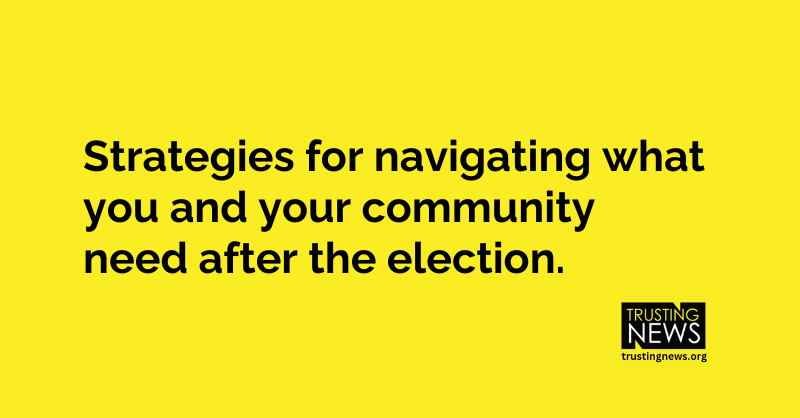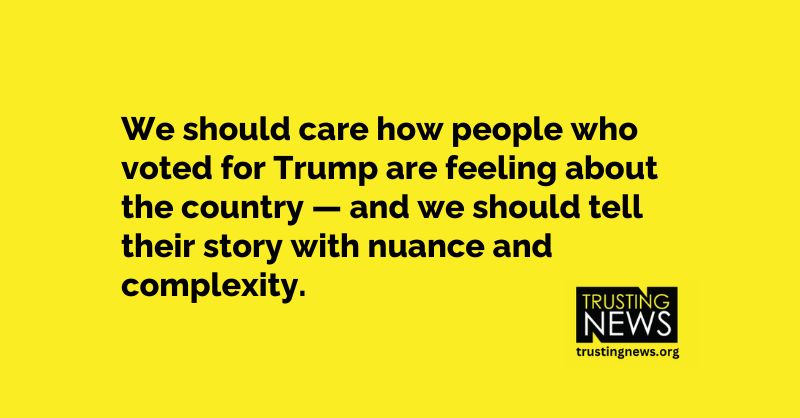
The election is over, now what? Here are four ways to navigate your overwhelm and focus on serving your community
Navigate your frustration and overwhelm with these 4 strategies
Thanks to all the journalists who are still covering and providing sensemaking around last week’s election. We hope you have been able to find some time to step away and take a break.
We know that, like the country, newsrooms are made up of people who are having a wide range of emotional reactions to the election results. We hope you have colleagues who are making room for and accommodating you as a human being. We also hope you work at a place where your own lens on the world is valued as a key to understanding the complex makeup of the people your journalism aims to serve.
If you have zero bandwidth or need to tap out to take care of yourself, please feel free to opt out of today’s Trust Tips. If you *are* in the headspace of trying to figure out what your community needs from the news, we’re here to try to be useful by sharing some thoughts from our team.
These stem from our own conversations and from a whole lot of listening to what we hear both journalists and news consumers saying they need. If you can take time to add your thoughts, or if our team can help support you and your newsroom directly, please don’t hesitate to reach out.
1. If you’re feeling a lack of control, focus your attention on local coverage and community.
For local journalists feeling exasperated or hopeless by the state of people’s information diets, especially around national elections, it might be helpful to tunnel your energy to local coverage.
Think about how you can help turn your community’s attention to local issues, local civic health, local public officials and your local neighbors. Get specific about the impact happening in your area, explaining what changes your community will see, or asking how your community feels. Double down on explaining the jobs of elected officials and hold them accountable for what they can control.
You might also find it helpful to start telling a different story about your newsroom and your work. We’ll likely see a rise in public narratives around journalists as enemies, so how can we share our unique value and our contributions to the community — especially in this moment?
This could look different depending on your focus and tone with your audience. Here are two great, but very different, examples: One from the Ashland Source that is more conversational and focused on a hyper-local community; and one from ProPublica, discussing their role as an investigative outlet.
2. Surprised by how your neighbors and community voted? Lean into curiosity.
Many people, and journalists, were surprised to see regions and entire states shift away from long-standing voting patterns — across a wide range of demographics and motivations. For some people, a vote for Trump was an endorsement of a candidate whose values, ideas and plans they truly believe in and support. A whole lot of others were willing to overlook things they found problematic because they were dissatisfied with the status quo.
Both those things are true, and much more. Can we hold multiple truths and resist easy answers? Can we get more comfortable with nuance and complication, and get more curious about whether people from our complex, diverse communities feel seen and understood by our coverage? And can we do that in a way that is consistent with our values and respects the dignity and humanity of people with different viewpoints?
We’re watching newsrooms like Capital B, which is focused on reflecting the needs of Black audiences, and The Advocate, which is serving LGBTQ+ audiences. If you are in a newsroom that is laser-focused on a specific group of people, your mandate might keep you more focused on a set of consistent values. The questions you’re asking will then be different than they are in newsrooms aiming to serve a geographic region. Either way, we need to stay curious about how people see the world and what they need from us.
One clear answer is to make space to have conversations with our communities. Whose voices are missing or overlooked — in your community’s conversations, in your newsroom conversations and in your coverage? Can you invest some time — as an individual journalist or as a newsroom — to touch base one-on-one and ask people about priorities and information needs. We have a community interview guide to help walk you through these listening efforts. And if you could use help getting buy-in for the work or deploying it across your newsroom, please let us know.
3. Remember that people are complex and sometimes contradict themselves.
If we want people across our complex, diverse communities to feel seen and understood by our coverage, we’ll have to do the difficult work of challenging our subconscious generalizations. We’ll have to continually ground ourselves in the reality that many people don’t fit neatly into buckets, and that knowing one thing about someone does not mean we have a full understanding of them.
We’ll be blunt about one main concern we have: Can we aim to not characterize Trump voters in a way that makes assumptions about them, villainizes them or is condescending or mocking? As we ask people about their goals and fears and motivations, can we start by giving them the benefit of the doubt?
We hope journalists try to check any personal quick judgments and actively choose to lean into open-mindedness and curiosity.
Two ways to start doing that:
- Consider how you’re labeling voters as we talk about trends and outcomes. Not all labels are bad, but it can be dangerous to use single descriptors to describe an entire group of people. As we analyze voting blocks and tell the story of values and priorities in our communities, let’s keep asking how we hold more space for complexity.
- Using this Anti-Polarization Checklist may help. We have shared this checklist a lot during this election season, but think it will be continually helpful. It’s a step-by-step checklist that helps you pause and think about how the framing, language and tone in your reporting would come across to different groups of people.
4. Feeling overwhelmed? Please care for yourself and your staff.
If you’re struggling to know what you need in this moment, or are a leader struggling to figure out how to support your team, check out this helpful framework around needs from Samantha Ragland, the Vice President of Journalism Programs at the American Press Institute.
Over the past few years, Ragland and her team have been investing a lot in creating resources and workshops for journalists around burnout and mental health.
“This week, journalists may not know what they need. They may not know next week either, and that’s okay. It doesn’t matter where you sit in the newsroom, what level of the hierarchy you occupy. When the weeks are difficult, it can be even more difficult to know what kind of support you need,” Ragland wrote in a LinkedIn post.
In the post, Ragland shares a list of anonymous responses from journalists on how they feel support. We recommend flipping through this list of ways to care for yourself and your colleagues. See which ones resonate.
Let us know how we can help support you
If our team can help support you and your newsroom, please reach out on LinkedIn, X (formerly Twitter) or email at info@trustingnews.org.
At Trusting News, we learn how people decide what news to trust and turn that knowledge into actionable strategies for journalists. We train and empower journalists to take responsibility for demonstrating credibility and actively earning trust through transparency and engagement. Learn more about our work, vision and team. Subscribe to our Trust Tips newsletter. Follow us on Twitter and LinkedIn.




